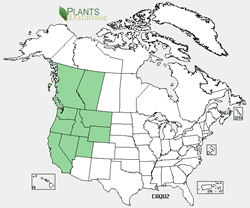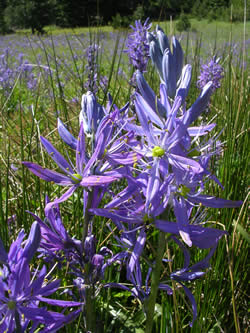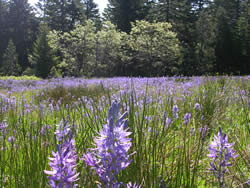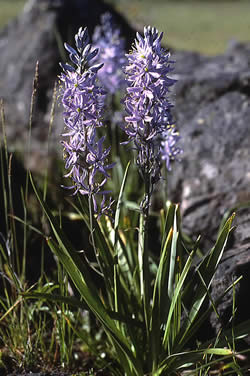Plant of the Week
 Range map of common camas. States are colored green where the species may be found.
Range map of common camas. States are colored green where the species may be found.
 Common camas flower. Photo by Jenny A. Moore.
Common camas flower. Photo by Jenny A. Moore.
Common Camas (Camassia quamash (Pursh) Greene)
By Russell Holmes
Common Camas is in the Liliaceae (lily Family), which contains 478 species in North America and approximately 4200 species worldwide. Liliaceae is a diverse plant family that has been divided into as many as 30 separate families, includes numerous important ornamentals, a number of important agricultural crops, and has been the source of valuable pharmacopoeia. By the 1850s, common camas was being shipped to the east coast and as far away as England for use in ornamental gardens. Collection of plants from the wild is strongly discouraged today. Those interested in using common camas as an ornamental should only collect limited amounts of seed from native populations or purchase seed or mature plants from reputable seed suppliers or native plant nurseries.
Bulbs of common camas are 1 to 5 centimeters (0.4 to 2 inches) in diameter. Leaves are usually less than 10 and are 1 to 6 decimeters (4 to 24 inches) long. The scape is 2 to 7 decimeters (8 to 28 inches) tall and typically longer than the leaves. The inflorescence is a loosely, many flowered raceme. Flowers are usually zygomorphic (bilaterally symmetric), sometimes actinomorphic (radially symmetric), blue to bluish-violet, with 12 to 35 millimeter (0.5 to 1.4 inches) long tepals. The fruit is a capsule 6 to 19 millimeters (0.2 to 0.7 inches) long. Common camas is highly variable across its range and tends to be divided into distinct geographical subspecies.
The range of common camas extends from British Columbia south to California and east to western Montana and Wyoming. Habitat is typically seasonally moist meadows that dry out by late spring.
Common camas bulbs were considered a delicacy by the Native American tribes within the range of the species including the Blackfoot, Cree, and Nez Perce. Bulbs would be steamed or pit cooked for one to three days breaking down complex carbohydrates into ample amounts of the sugar fructose. A full one third of a bulbs cooked weight becomes fructose when prepared in this fashion. Native Americans would dry out the cooked bulbs and grind them into a meal. The meal was used in variety of ways. At times it would be mixed with water to form a batter and then cooked like a pancake. Often the meal would be mixed with water and formed into large bricks and then cooked and stored for future use.
The Nez Perce at Weippe Praire, Idaho introduced Lewis and Clark to common camas in September 1805. At their first meeting, the Nez Perce gave members of the expedition buffalo meat, salmon and various roots including what the Nez Perce called quamash. Clark wrote that evening in his journal, “I find myself very unwell all the evening from eating the fish and roots to freely.” Lewis wrote a detailed description of the plant, one of the most detailed accounts of any plant he collected on the entire expedition, while camped at Weippe Prairie.
For More Information
PLANTS Profile - Camassia quamash, Common Camas



